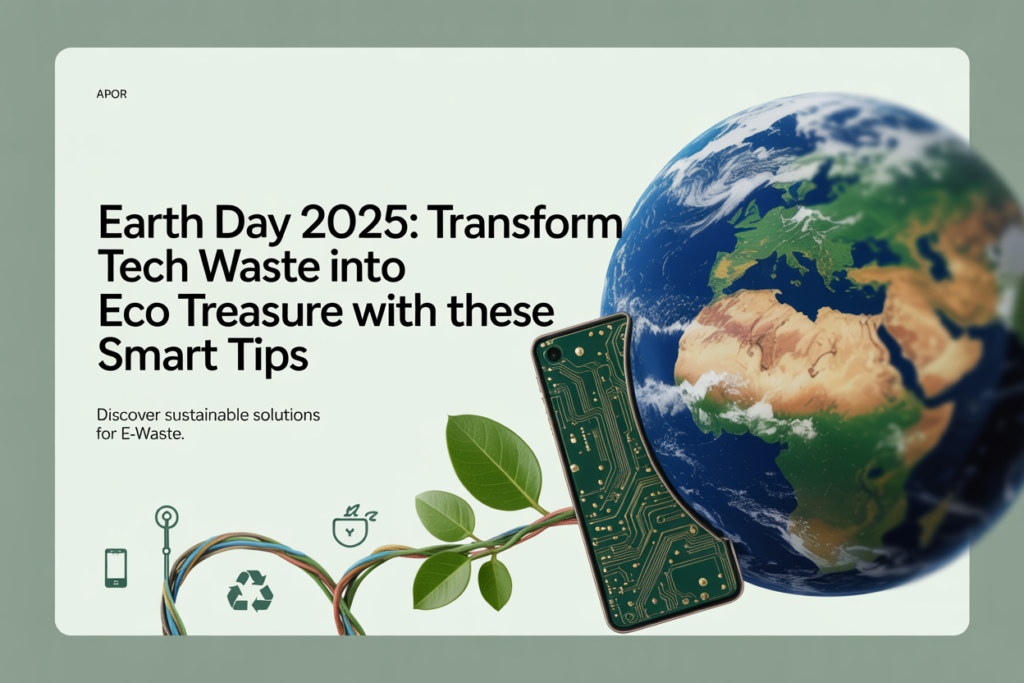
As Earth Day 2025 approaches, it’s time to look at one of the most pressing yet often overlooked environmental issues: electronic waste. Every year, millions of tons of tech clutter pile up in landfills, releasing toxic substances and missing a crucial opportunity for sustainability. At a time when climate action is urgent, we have the tools and the responsibility to reverse this trend. Here’s how you can turn your old gadgets into green gold through smart, sustainable moves.
Clear Out the Clutter: Start Your Eco-Journey at Home

The first step in honoring Earth Day is to assess the tech clutter in your home. From that retired smartphone in the drawer to the outdated laptop collecting dust, unused electronics quietly contribute to a growing e-waste problem.
Take a moment to audit every tech item in your house:
- Old cell phones
- Defunct chargers
- Broken tablets
- Outdated printers
- Worn-out cables and accessories
Creating a tech inventory allows you to sort what can be reused, recycled, or responsibly disposed of. Many people are shocked by how much electronic waste they’ve accumulated. By identifying this clutter, we not only reclaim physical space but also take a significant step toward digital minimalism and environmental awareness.
Keep the Good Going: Extend the Life of What Works

Before you rush to toss or trade, assess the functionality of your electronics. Devices that are still in working condition can often be repurposed, donated, or gifted. Not everything old is obsolete some devices just need a software update, a new battery, or a clean-up to work like new again.
Consider these eco-smart ideas:
- Donate usable tech to schools, community centers, or nonprofits.
- Reassign devices as dedicated tools (e.g., turn an old tablet into a smart home hub).
- Install lightweight operating systems like Linux on older computers to revive them.
By keeping devices in circulation longer, we significantly reduce the demand for new manufacturing, which means fewer natural resources are mined, processed, and wasted. This single step is a power move in sustainability.
Recycle with Purpose: E-Waste the Right Way

Responsible recycling is a cornerstone of Earth Day efforts. Electronics contain valuable materials like gold, silver, and rare earth metals. If these aren’t reclaimed through proper recycling, they end up wasted and sometimes pollute the environment.
Look for certified e-waste recycling programs such as:
- R2 (Responsible Recycling)
- e-Stewards Certification
- Municipal recycling centers with e-waste days
Avoid dumping e-waste in general trash bins. Instead:
- Visit manufacturer websites for recycling programs.
- Use retailer drop-off programs from companies like Best Buy, Staples, or Apple.
- Explore local recycling drives during Earth Day campaigns.
Proper recycling ensures that tech waste is disassembled and processed safely, preventing harmful chemicals like lead and mercury from leaching into soil and water supplies.
Trade In and Trade Up: Upgrade Sustainably

Tech manufacturers are increasingly offering trade-in programs that reward users for returning old devices. These initiatives are designed to encourage sustainable upgrading while minimizing environmental impact.
Major companies, including Apple, Samsung, and Google, offer incentives like:
- Store credits
- Discounts on new purchases
- Gift cards
- Device refurbishment
Through these programs, your old smartphone or laptop is either recycled or reconditioned for secondhand use, cutting down waste and giving technology a second life. If you’re eyeing a device upgrade in 2025, make sure your old gear helps offset your environmental footprint instead of adding to it.
Fix It Before You Ditch It: Repair is the New Recycling

Repair culture is rising, and for good reason. Fixing devices instead of discarding them extends their usability and reduces the demand for new products. Simple repairs can drastically increase a device’s lifespan.
What you can do:
- Replace cracked screens, worn-out batteries, or malfunctioning ports.
- Use DIY resources like iFixit, which offers step-by-step repair guides.
- Support local tech repair shops or certified refurbishers.
- Learn basic maintenance to prevent breakdowns.
With the Right to Repair movement gaining global traction, more manufacturers are making parts and manuals available to consumers. By choosing to repair, you contribute to a more circular economy where products are valued beyond their first lifecycle.
It’s All Part of Apple 2030: Tech Giants Going Green

Tech industry leaders are making major sustainability pledges. Apple’s 2030 environmental goals serve as a benchmark for reducing the carbon footprint across entire supply chains. Their promise includes:
- Carbon-neutral products by 2030
- Use of recycled materials in devices
- Renewable energy for operations
- Eco-friendly packaging
- Enhanced device longevity
By supporting brands committed to green innovation, consumers play a vital role in reshaping the industry. Every trade-in, repair, or recycled device is a vote for sustainability.
Earth Day Is a Tech-Wise Opportunity
Earth Day 2025 is more than a reminder it’s a call to action. Technology has the potential to either burden or benefit the planet, depending on how we use, maintain, and discard it. Whether you’re clearing out drawers, repairing an old tablet, or trading in your phone, each move counts.
These green tech habits not only reduce environmental harm but also promote smarter consumer behavior. Sustainability isn’t about sacrifice it’s about strategy, awareness, and meaningful change. Join the movement this Earth Day, and let your devices become part of the solution not the pollution.


